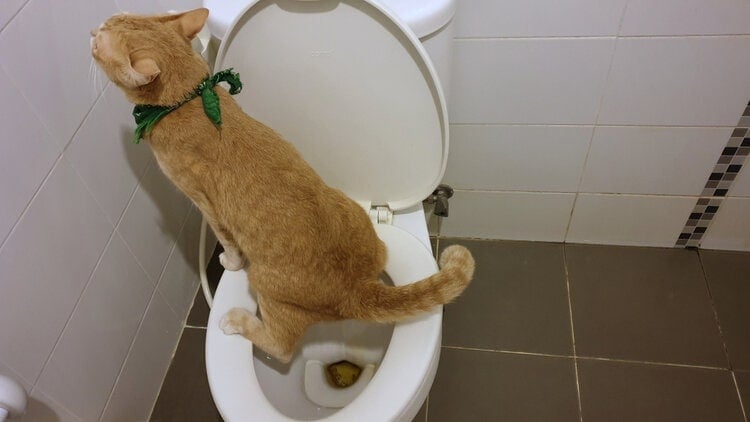Prevent Clogs and Damage: Never Flush Cat Poop Down Your Toilet - Professional Recommendations
Prevent Clogs and Damage: Never Flush Cat Poop Down Your Toilet - Professional Recommendations
Blog Article
What're your opinions regarding How to Dispose of Cat Poop and Litter Without Plastic Bags?

Intro
As cat owners, it's important to be mindful of exactly how we get rid of our feline buddies' waste. While it might appear hassle-free to flush pet cat poop down the bathroom, this practice can have damaging consequences for both the atmosphere and human wellness.
Ecological Impact
Purging feline poop presents unsafe pathogens and parasites right into the supply of water, posing a substantial danger to marine ecosystems. These impurities can negatively impact aquatic life and compromise water quality.
Health Risks
In addition to environmental worries, purging pet cat waste can likewise present health threats to people. Feline feces may contain Toxoplasma gondii, a bloodsucker that can cause toxoplasmosis-- a possibly extreme disease, specifically for expectant ladies and individuals with damaged immune systems.
Alternatives to Flushing
Thankfully, there are more secure and a lot more liable methods to dispose of feline poop. Take into consideration the following options:
1. Scoop and Dispose in Trash
The most typical approach of getting rid of pet cat poop is to scoop it right into a biodegradable bag and throw it in the garbage. Make certain to utilize a committed litter scoop and dispose of the waste quickly.
2. Usage Biodegradable Litter
Go with biodegradable cat litter made from products such as corn or wheat. These clutters are environmentally friendly and can be safely thrown away in the garbage.
3. Bury in the Yard
If you have a lawn, think about hiding pet cat waste in an assigned area far from veggie yards and water sources. Be sure to dig deep adequate to avoid contamination of groundwater.
4. Set Up a Pet Waste Disposal System
Invest in a pet dog garbage disposal system specifically created for cat waste. These systems use enzymes to break down the waste, reducing smell and ecological impact.
Final thought
Accountable pet dog possession expands past offering food and shelter-- it also entails proper waste monitoring. By refraining from flushing pet cat poop down the bathroom and going with alternative disposal techniques, we can lessen our ecological impact and protect human wellness.
Why Can’t I Flush Cat Poop?
It Spreads a Parasite
Cats are frequently infected with a parasite called toxoplasma gondii. The parasite causes an infection called toxoplasmosis. It is usually harmless to cats. The parasite only uses cat poop as a host for its eggs. Otherwise, the cat’s immune system usually keeps the infection at low enough levels to maintain its own health. But it does not stop the develop of eggs. These eggs are tiny and surprisingly tough. They may survive for a year before they begin to grow. But that’s the problem.
Our wastewater system is not designed to deal with toxoplasmosis eggs. Instead, most eggs will flush from your toilet into sewers and wastewater management plants. After the sewage is treated for many other harmful things in it, it is typically released into local rivers, lakes, or oceans. Here, the toxoplasmosis eggs can find new hosts, including starfish, crabs, otters, and many other wildlife. For many, this is a significant risk to their health. Toxoplasmosis can also end up infecting water sources that are important for agriculture, which means our deer, pigs, and sheep can get infected too.
Is There Risk to Humans?
There can be a risk to human life from flushing cat poop down the toilet. If you do so, the parasites from your cat’s poop can end up in shellfish, game animals, or livestock. If this meat is then served raw or undercooked, the people who eat it can get sick.
In fact, according to the CDC, 40 million people in the United States are infected with toxoplasma gondii. They get it from exposure to infected seafood, or from some kind of cat poop contamination, like drinking from a stream that is contaminated or touching anything that has come into contact with cat poop. That includes just cleaning a cat litter box.
Most people who get infected with these parasites will not develop any symptoms. However, for pregnant women or for those with compromised immune systems, the parasite can cause severe health problems.
How to Handle Cat Poop
The best way to handle cat poop is actually to clean the box more often. The eggs that the parasite sheds will not become active until one to five days after the cat poops. That means that if you clean daily, you’re much less likely to come into direct contact with infectious eggs.
That said, always dispose of cat poop in the garbage and not down the toilet. Wash your hands before and after you clean the litter box, and bring the bag of poop right outside to your garbage bins.
https://trenchlesssolutionsusa.com/why-cant-i-flush-cat-poop/

We had been introduced to that editorial on Don’t flush cat feces down the toilet from an associate on a different site. So long as you liked our blog entry plz do not forget to pass it around. I take joy in reading our article about Can You Flush Cat Poop Down The Toilet?.
Go Deal Report this page